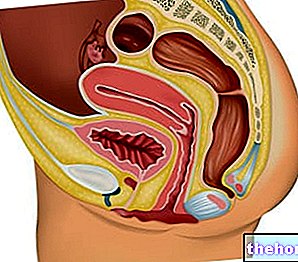What is that?
The transvaginal ultrasound or more simply TVS (Trans-Vaginal Sonography) is a diagnostic imaging technique that investigates the morphology and health of the female internal genital organs.

Thanks to this examination it is possible to study the uterus, ovaries and appendages, and to check pregnancy in the first trimester or in the context of assisted reproduction techniques.
Transvaginal ultrasound is based on the emission of high frequency sound waves (inaudible to the human ear) by a probe inserted into the vagina; as in any other ultrasound examination, the sound waves emitted by the device are partially reflected from the tissues they encounter, in relation to their density (echo phenomenon). The sound waves thus reflected are picked up by the same probe that generated them, and processed by a computer to reconstruct real-time images of the anatomical regions studied.
When and why is it done?
Transvaginal ultrasound is typically used in women with infertility problems, abnormal bleeding (which can be linked to rather common benign causes, such as fibroids or polyps), pelvic pain of unknown origin, amenorrhea, congenital malformations of the uterus and ovaries, and before suspicion of tumors or infections.
It can also be used at the end of the first month of pregnancy (obstetric ultrasound) due to its ability to highlight the images of the embryo and its appendages earlier, with definition and image quality clearly superior to transabdominal ultrasound. In later stages of pregnancy. , transvaginal ultrasound can be used if a better visualization of the structures adjacent to the cervix is required.
We remind you that transvaginal ultrasound does not involve the use of ionizing radiations (such as those used during radiographs) and therefore does not involve any danger for the mother and the fetus.
How it is done
Transvaginal ultrasound can replace trans-abdominal pelvic ultrasound (TAS), which must be strictly performed with a full bladder to facilitate visualization and study of the pelvic organs. On the contrary, transvaginal ultrasound is preferably performed at empty bladder, sparing the patient this discomfort; on the other hand, the possible must not be overlooked discomfort produced by the probe and any manual operations of the doctor, which can be used to move the uterus and other pelvic organs. We remind you that the transvaginal ultrasound is very similar to a gynecological examination; the patient is in fact lying supine on a bed in a genecological position. The probe, covered by a kind of condom sprinkled with a sterile lubricant, is then gently inserted into the vagina. Generally no special preparation is required in the days preceding the ultrasound examination; all documentation relating to any examinations previously performed must be brought to the clinic at the time of the ultrasound scan, which can be performed at any stage of the menstrual cycle.
The transvaginal approach for the investigation of the pelvic organs allows to obtain more precise and detailed images from the anatomical study of the region, given the proximity of the probe to the structures to be examined, and given the lack of organs and tissues encountered in the transabdominal route (such as precisely the bladder and the adipose layer, problematic in obese women). In particular, thanks to the use of higher insonation frequencies, transvaginal ultrasound allows to obtain anatomical details of the uterus, ovaries and endometrium that cannot be reproduced with the TAS. Often, however, transvaginal ultrasound and transabdominal pelvic ultrasound are used together to obtain an overall view of the health of the pelvic organs. The transabdominal / transvesical ultrasound in fact allows a better visualization of the superficial and distal structures to the vagina.




























